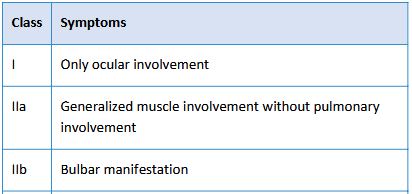Management of Myasthenia Gravis through Herbomineral Drug - A Case Study
DOI:
https://doi.org/10.21760/jaims.9.11.41Keywords:
Myasthenia Gravis, Ojovyapat, Ojovisramsa, RasayanaAbstract
Ayurveda is an oldest traditional medicine system that believes on natural and holistic approach of treatment for various diseases. It is the science of healthy life. Myasthenia gravis is a chronic autoimmune neuromuscular disease that causes weakness in the skeletal muscles, which are responsible for breathing and moving parts of the body including the arms and legs. Myasthenia gravis affects approximately 2 out of every 100000 people and can occur at any age of 18 and 25 years. In Ayurveda, the symptoms of myasthenia gravis closely resemble with Vata Vyadhi. As per Ayurvedic perspective, dysregulation of the immune function occurs on account of either Ojovyapat or Ojovisramsa the dearrangement or displacement of Ojas resulting from inherent disposition, nutritional inadequacy, digestive or eliminative, vitiation of the Doshas by tissues destructions and metabolic disruption, unresolved psychological trauma or protected somatic stress, or environment or Karmic factors may lead to develop myasthenia gravis. Ojas disorders still they have no satisfactory management. Myasthenia gravis is mainly due to Srotorodha and Agnidusti. Agnidusti leads to formation of Samavastha in the body which provide hinderance in the functioning of body. A case study of Myasthenia gravis was studied and managed accordingly symptomatic improvement was noted after 21 days of treatment.
Downloads
References
Aknin, Sonia Berrih. (2014). Myasthenia gravis: A comprehensive review of immune dysregulation and etiological mechanisms. Journal of Autoimmunity, Volume 52, 90-100.
Ralston, S.H., Penman, I. D., Strachan, M. W. J., & Hobson, R. [Eds.]. [2018]. Davidson’s principles and practice of Medicine [23rd Ed.] Elsevier Health Sciences chapter 25 pp 1141.
Jameson. Fauci. Kasper. Hauser. Longo. Localzo. [2018]. Harrison’s principle of internal medicine. McGraw Hill Education. Chapter Neurological diseases.
Dresser, Soliven, Laura, Betty. (2021). Myasthenia Gravis: Epidemiology, Pathophysiology and Clinical Manifestations. MDPI, 10(11), 2235.
Ralston, S.H., Penman, I. D., Strachan, M. W. J., & Hobson, R. [Eds.]. [2018]. Davidson’s principles and practice of Medicine [23rd Ed.] Elsevier Health Sciences chapter 25 pp 1142.
Maharshi Agnivesha, Charaka Samhita, Indriya sthana, (3/6 ). In S.N. Shastri (eds), Vidyotini Hindi Commentary. Reprint 2018ed. Chaukhambha Bharati Academy; Varanasi: 2018, pp. 979.
Maharshi Agnivesha, Charaka Samhita, Indriya sthana, (8/25 ). In S.N. Shastri (eds), Vidyotini Hindi Commentary. Reprint 2018ed. Chaukhambha Bharati Academy; Varanasi: 2018, pp. 1002.
Acharya Sushruta, Sushrut Samhita, Sutra sthana (15/29 ) In Ambikadatta Shastri (eds), Hindi Commentary. Reprint 2014 ed. Chaukhambha Sanskrit Sansthan, Varanasi: 2014, page no. 80.
Damian, Maxwell & De Visser, Marianne. (2022). Emergencies in Neuromuscular Disorders. Springer Nature Switzerland. pp 39-75.
Shri Govind Das Sen, Bhaishajya Ratnawali, Atisar chikitsaprakaran (15/119)In Shri Kaviraj Ambikadatta Shastri(eds), Vidyotini Hindi Commentary analysis. Reprint 2014ed., Chaukhambha Sanskrit Sansthan, Varanasi. 2014, page no.264.
Shri Govind Das Sen, Bhaishajya Ratnawali, Hikka Shwasaroga chikitsaprakaran(16/57-60)In Shri Kaviraj Ambikadatta Shastri(eds), Vidyotini Hindi Commentary analysis. Reprint 2014ed., Chaukhambha Sanskrit Sansthan, Varanasi. 2014.
Kumar, Jadar, Shashi, Prashant. (2023). Critical Review of Sameerpannag Rasa: A Kupipakwa Rasayana Yoga. Journal of Ayurvedic Sciences, 11(1), 31-35.
Negi, Prashar, Jyoti, Bharat. (2019). Sitopaladi Churna As Anti-Tussive: A Review. International Journal of Health and Clinical Research, 2(6), 1-5.
Sakharam Bhokardanker, Prashant. (2019). AN OVERVIEW OF SHATAVARI (ASPARAGUS RACEMOSUS) AN AYURVEDIC DRUG. International Journal of Ayurveda and Pharma Research, 7(4), 60-65.
Gupta, Nath Bansal, Sonu, Ravinder. (2021). Ashwagandha (Withania somnifera) – a herb with versatile medicinal properties empowering human physical and mental health. Journal of Pre Clinical Research and Clinical Research, 15(3), 129-133.
Swapana, Nagaveni, E, P. (2015). Evaluation of Antioxidant activity of Marketed Ayurvedic Formulations- Balarishta. RJJP, 7(2), 107-110.
Nandkishor Bhaurao Kale. (2022). TO STUDY EFFICACY OF JIVANTYADI GHRIT AS ADD-ON TREATMENT IN PTB TREATING WITH AKT (DOTS) REGIMEN. Journal of Ayurvedic Herbal and Integrative Medicine, 2(1), 1-12.
Salah sulaiman. (2023). PHYTOCHEMICAL ANALYSIS OF MASHABALADI KWATHA CHURNA. International Journal Of Creative Research Thoughts, 11(4), 13-19.
Acharaya Vagbhatta, Astang hridyam, Sutra sthana (15/9-10) Hindi commentary, Chukhamba Krishandas Academy; Varanasi.2020.















